The world of dogs is filled with a wide variety of breeds, and some of the most impressive ones are the largest. These giant dogs come in various sizes and have fascinating facts that make them truly unique. Let’s take a closer look at the top 10 biggest dog breeds and explore their astonishing sizes and interesting characteristics.
Biggest Dog Breeds Key Takeaways:
- The top 10 biggest dog breeds include the Irish Wolfhound, Saint Bernard, Newfoundland, Dogue de Bordeaux, Leonberger, Anatolian Shepherd, Neapolitan Mastiff, Great Dane, and more.
- Giant dog breeds require larger living spaces and have higher expenses for food and veterinary care.
- Proper training and socialization are crucial for giant breeds to prevent behavioral issues.
- Owning a giant breed comes with specific considerations and responsibilities.
- Giant dog breeds add a special presence and loyal companionship to our lives.
Irish Wolfhound
The Irish Wolfhound is a breed with a long history and a truly impressive size. It has ancient roots, but the modern breed was revived in the 19th century by Captain Graham, who used several different breeds in its development. Once fully grown, the Irish Wolfhound is a gentle giant, but as puppies, they can be boisterous and clumsy. Despite their size, many people can’t resist having more than one Irish Wolfhound as a companion.
The Irish Wolfhound is known for its dignified appearance and noble demeanor. These gentle giants have captured the hearts of many dog lovers with their loyal and friendly nature. They are true companions and thrive on human companionship and affection.
This breed’s size and strength can be quite remarkable. Let’s take a closer look at the fascinating dimensions of the Irish Wolfhound:
| Attribute | Male | Female |
|---|---|---|
| Height | 32 inches (81 cm) and up | 30 inches (76 cm) and up |
| Weight | 140 pounds (63 kg) and up | 115 pounds (52 kg) and up |
| Life Expectancy | 6-8 years | 6-8 years |
The Irish Wolfhound’s impressive size and regal presence make it a perfect example of a gentle giant in the world of dog breeds. Their unique combination of strength and gentle temperament makes them wonderful family pets for those who have the space to accommodate their large size.
Saint Bernard
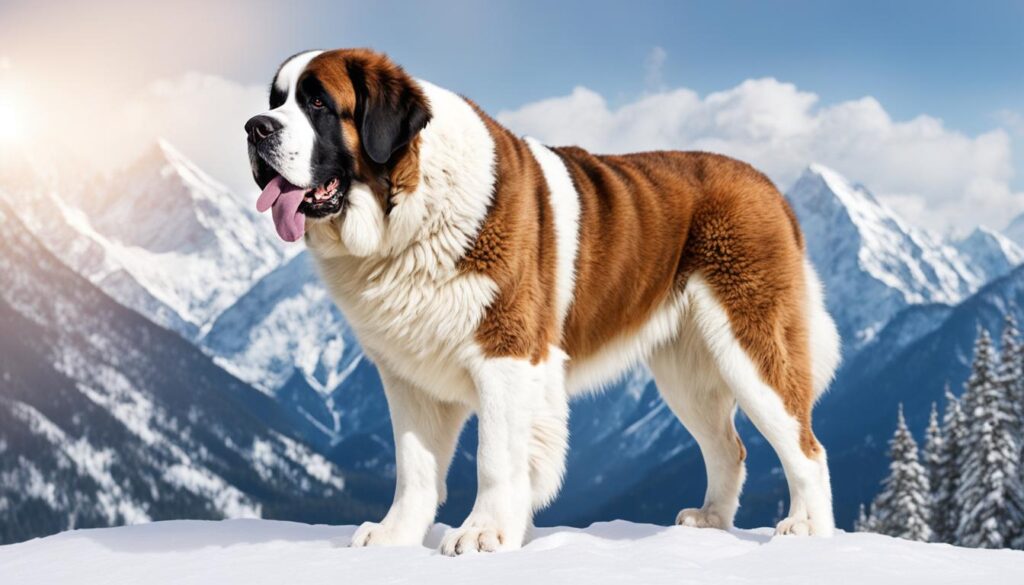
I have always been fascinated by the Saint Bernard, a giant breed that is often associated with the image of a large and majestic dog. With an average height of 74cms (but sometimes much bigger), these dogs possess a muscular body that commands attention.
Originating from a Swiss monastery at Great St Bernard Pass, Saint Bernards were initially bred as protection dogs, guarding the monastery and its inhabitants from potential threats. However, over time, they became known for their companionship and incredible rescue abilities.
Despite their imposing size, Saint Bernards are incredibly friendly and easy-going, making them great lap dogs and beloved family pets. Their gentle and patient nature has earned them a reputation as excellent companions, especially for families with children.
| Features | Description |
|---|---|
| Size | One of the largest dog breeds, reaching an average height of 74cms (29 inches) and weighing between 64-120kgs (140-264 pounds). |
| Appearance | They have a massive frame with a wide chest and a well-proportioned body. Their head is broad and features a gentle expression. The most common coat colors are white with red or brown patches. |
| Temperament | Saint Bernards are known for their friendly and gentle nature. They are patient and tolerant, particularly with children, and get along well with other dogs and pets. They are also very sociable and thrive on human companionship. |
| Lifespan | The average lifespan of a Saint Bernard is around 8-10 years. |
| Exercise | They require moderate daily exercise, including walks and playtime. However, it’s important to avoid excessive exercise when they are young to protect their developing joints. |
Rescue and Famous Dogs
While Saint Bernards are known for their size and gentle demeanor, they are perhaps most famous for their role in alpine rescues. These extraordinary dogs were trained to locate lost or injured travelers in the treacherous Swiss Alps and provide them with warmth and companionship until help arrived.
One famous dog, named Barry, is credited with saving the lives of over 40 people during his lifetime. His heroic efforts and those of other Saint Bernards have been immortalized in books, movies, and popular culture.
“The loyalty, bravery, and incredible rescue abilities of Saint Bernards have firmly cemented their place in history and in the hearts of dog lovers around the world.”
Overall, the Saint Bernard is a remarkable giant breed with a rich history and endearing qualities. Their imposing size combined with their friendly nature makes them a beloved choice for families seeking a loyal and gentle companion.
Newfoundland
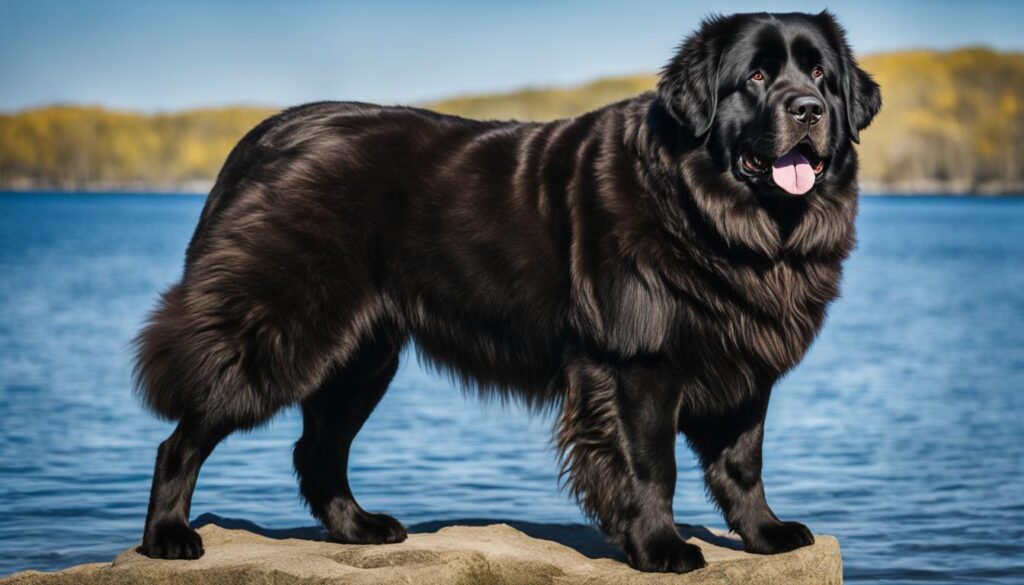
When it comes to water-loving dogs, the Newfoundland, also known as Newfie, takes the spotlight. These giant and gentle creatures have an innate passion for swimming, which they begin to display even as playful puppies. Originally bred on the picturesque island of Newfoundland in Canada, these dogs served as hardworking sled and cart dogs, as well as adept water dogs that retrieved heavy nets.
What sets the Newfoundland apart is its heavy, oily coat and webbed feet, which make them exceptional swimmers. Their large size and muscular build allow them to handle the demands of water-related activities with ease. Despite their strength, Newfoundlands have a calm and gentle temperament, making them excellent companions for families and individuals alike.
As a testament to their water-loving nature, Newfoundlands are frequently involved in various water sports today, including water rescue and competitive swimming events. Their remarkable abilities in the water, combined with their endearing personalities, have earned them a special place in the hearts of dog lovers worldwide.
Characteristics of Newfoundland:
| Characteristics | Description |
|---|---|
| Size | One of the largest dog breeds, with males weighing between 130-150 pounds and females weighing between 100-120 pounds. |
| Appearance | Thick double coat, featuring a dense, water-resistant undercoat and a straight, coarse outer coat. Comes in various colors, including black, brown, and Landseer (white with black markings). |
| Temperament | Friendly, patient, and good-natured. Known for their loyalty and gentle disposition. |
| Exercise | Moderate exercise needs, including daily walks and engaging in activities that stimulate their mind and body. |
| Training | Requires consistent and positive reinforcement training methods. Known to be intelligent and eager to please. |
| Health | Potentially prone to certain health issues, such as hip and elbow dysplasia, heart problems, and obesity. Regular veterinary check-ups recommended. |
| Lifespan | Average lifespan of 8-10 years. |
Dogue de Bordeaux
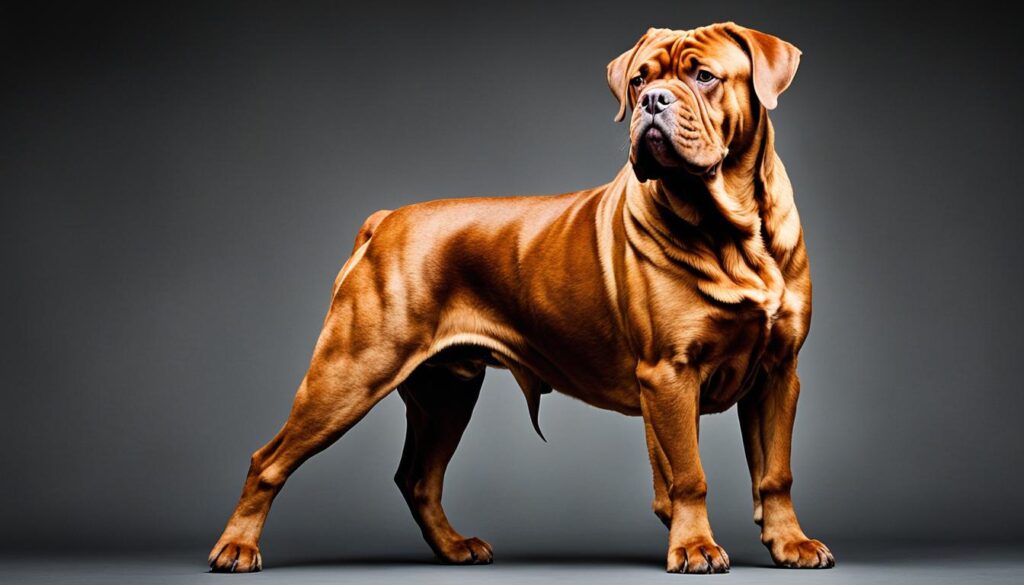
The Dogue de Bordeaux, also known as the French Mastiff, is a magnificent giant breed with a distinctive appearance that captures the hearts of many dog lovers. With its reddish fawn coloration and heavily wrinkled face, this breed exudes a unique and endearing charm.
Originating from France, the Dogue de Bordeaux has a rich and varied history. This breed has served in various roles throughout the years, including farm work, war dogs, pit fighting, and guard dogs. Today, they are commonly seen as loyal companions and successful show dogs.
Distinctive Features
The Dogue de Bordeaux is characterized by its wrinkled face, which adds to its expressive and lovable demeanor. Their muscular build and sturdy frame contribute to their powerful appearance, further enhanced by their imposing size.
Temperament and Personality
Despite their size and history as working dogs, the Dogue de Bordeaux is known for its calm and gentle nature. They are loyal and affectionate toward their families, making them excellent companions, especially for experienced dog owners.
Size and Weight
While the Dogue de Bordeaux falls on the smaller end of the giant breed scale, they are still a hefty and sizeable dog. According to the American Kennel Club, male Dogues de Bordeaux typically stand between 23.5 and 27 inches tall at the shoulder, while females are slightly smaller, ranging from 22 to 25.5 inches. The breed’s weight can range from 110 to 145 pounds for males and 99 to 120 pounds for females.
Health and Care
Like all giant breeds, the Dogue de Bordeaux requires proper care and attention to maintain their health and well-being. Regular exercise, a balanced diet, and routine veterinary check-ups are essential for their overall health. Additionally, their wrinkled face requires special care to prevent skin infections and irritation.
Recommended Diet
A high-quality diet that meets the unique nutritional needs of giant breeds is crucial for the Dogue de Bordeaux. Consulting with a veterinarian to determine the appropriate portion sizes and nutrient balance is highly recommended.
Training and Socialization
Early training and socialization are essential for the Dogue de Bordeaux to ensure they grow into well-mannered and obedient companions. Consistent, positive reinforcement techniques and patient handling are key to their successful development.
Leonberger: The Majestic Lion from Germany
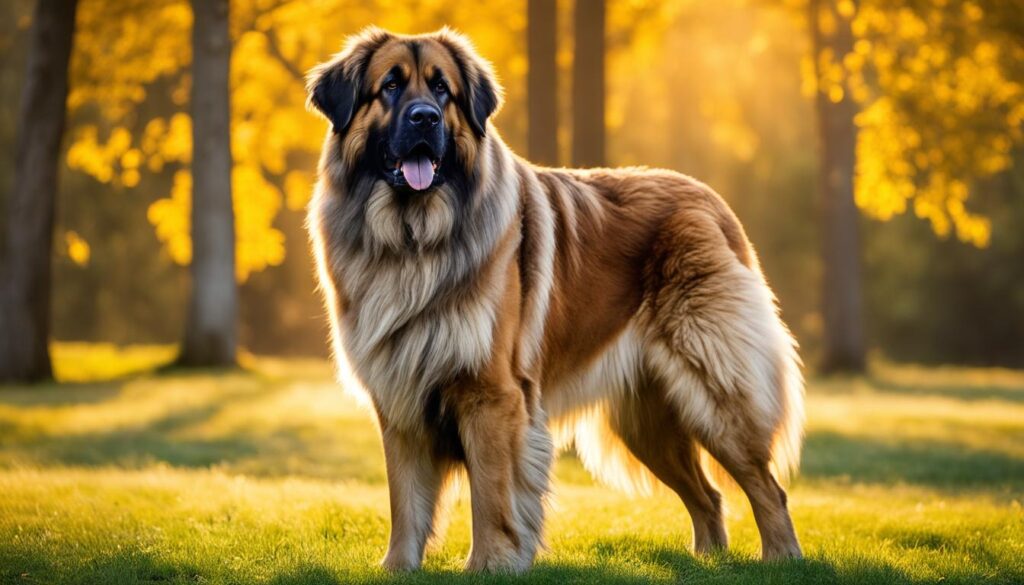
The Leonberger is a glamorous giant breed that exudes resilience and resembles a majestic lion. Originating from Leonberg, Germany, this breed was meticulously created by crossing St Bernards, Newfoundlands, and Pyrenean Mountain Dogs to achieve its striking lion-like appearance.
Known for their attractive features and gentle nature, Leonbergers have a remarkable history serving as farm and guard dogs, as well as loyal companions to the wealthy and noble. Over the years, they have captivated many with their regal presence and unwavering loyalty.
Leonbergers require a spacious home and garden that can accommodate their substantial size. Their appealing appearance is matched by their steady and even-tempered nature, making them a favorite among dog enthusiasts worldwide.
Leonbergers exude a majestic presence that is truly awe-inspiring. From their lion-like mane and powerful build to their gentle disposition, they are the epitome of magnificence and grace. -Michelle Adams, Leonberger Enthusiast and Breeder
Key Characteristics of Leonbergers
- Size: Leonbergers are a giant breed, with males typically weighing between 110 and 170 pounds (50-77 kg) and reaching a height of 28 to 31.5 inches (71-80 cm) at the shoulder. Females are slightly smaller, weighing between 90 and 140 pounds (41-64 kg) and measuring 25.5 to 29.5 inches (65-75 cm) tall.
- Appearance: Their lion-like mane, deep chest, and muscular build contribute to their majestic appearance. Leonbergers have a water-resistant double coat that comes in various shades of golden, red, or brown with a black mask.
- Temperament: Known for their gentle and friendly nature, Leonbergers are excellent family dogs and get along well with children and other pets. They are intelligent, trainable, and eager to please their owners.
- Exercise needs: Despite their imposing size, Leonbergers have moderate exercise requirements. Daily walks, playtime, and mental stimulation are essential to keep them happy and healthy.
Leonbergers: The Perfect Companions
With their majestic lion-like appearance and gentle nature, Leonbergers make wonderful companions for individuals and families alike. Their loving and loyal demeanor, combined with their striking presence, adds a touch of elegance to any household.
| Pros | Cons |
|---|---|
| Strong and loyal protectors | Require a spacious living environment |
| Gentle and friendly temperament | Regular grooming and moderate shedding |
| Great with children and other pets | Potential health issues like hip dysplasia |
Whether strolling through the park or lounging at home, the Leonberger’s magnificent presence will surely turn heads and fill hearts with admiration. Their regal charm and affectionate nature make them an ideal choice for those seeking a loyal and majestic companion.
Anatolian Shepherd
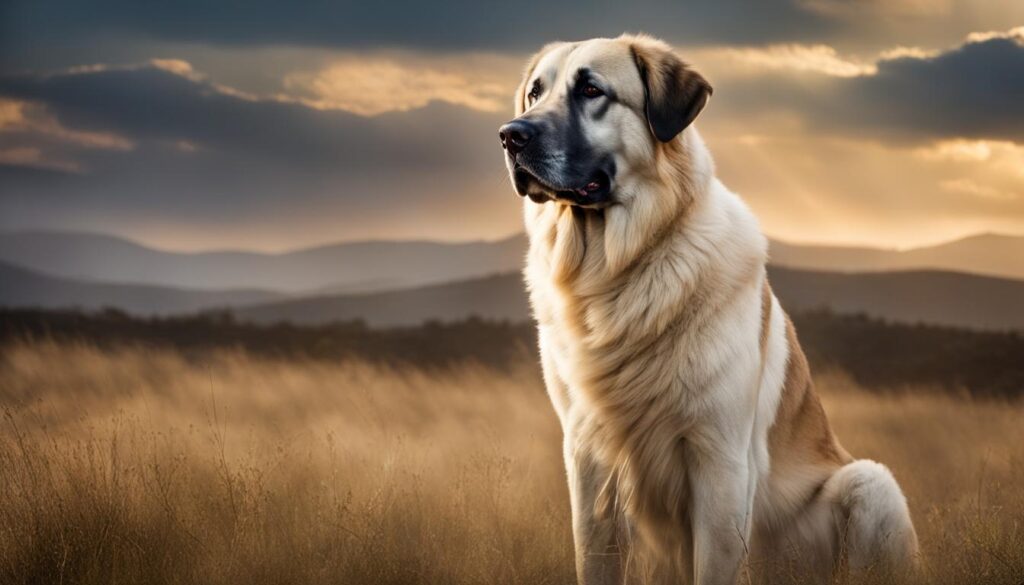
The Anatolian Shepherd is a majestic giant breed known for its impressive size and exceptional protective instincts. Originating from the Central Anatolian Plateau, these magnificent dogs have a rich history of guarding livestock and assisting in their movement across the rugged terrain.
Characterized by their sturdy build and athleticism, Anatolian Shepherds are natural protectors. Their primary role is to safeguard their familiar people and the livestock entrusted to their care. These loyal guardians exhibit vigilance, fearlessness, and a strong territorial instinct, making them ideal for livestock guarding. Their powerful presence alone is often enough to deter potential predators, while their agility and quick reflexes allow them to take swift action when needed.
Experienced ownership is essential for Anatolian Shepherds due to their protective nature and the complex training they require. These dogs flourish in large, securely fenced properties where they can roam freely and fulfill their guardianship responsibilities. Their intelligence and trainability make it possible to establish a strong bond with their owners and ensure they receive the proper guidance and direction.
Summary of Anatolian Shepherd’s Characteristic Traits:
| Characteristics | Description |
|---|---|
| Size | The Anatolian Shepherd is a large breed, with males typically reaching heights of 28-30 inches (71-76 cm) and females slightly smaller at 26-28 inches (66-71 cm). They have a strong and robust build, weighing between 80-150 pounds (36-68 kg). |
| Coat | Anatolian Shepherds have a thick double coat that provides insulation in different weather conditions. Their coarse outer coat and dense undercoat help protect them from extreme cold or heat. |
| Color | Their coat comes in various colors, including fawn, brindle, white, and pinto, often with a black mask on their face. |
| Temperament | They are calm, confident, and intelligent dogs that are deeply devoted to their families. While they can be reserved with strangers, they are loyal and affectionate towards their immediate circle. |
| Exercise | Anatolian Shepherds require regular exercise, such as long walks or engaging in interactive play sessions. Mental stimulation through training exercises and problem-solving activities is also necessary to keep them mentally sharp. |
| Health | Overall, Anatolian Shepherds are a healthy breed with few genetic health issues. However, like all giant breeds, they are prone to certain conditions such as hip dysplasia and bloat, so regular veterinary check-ups and a balanced diet are crucial for their well-being. |
“The Anatolian Shepherd’s natural guarding ability and unwavering loyalty have been essential for protecting livestock throughout history. Their adaptive nature and incredible work ethic make them indispensable companions for farmers and ranchers.” – Dr. Emily Thompson, Animal Behaviorist.
In conclusion, the Anatolian Shepherd is a remarkable giant breed that combines size, strength, and intelligence. With a rich heritage in livestock guarding on the Central Anatolian Plateau, these dogs excel in their protective duties. Their distinctive characteristics, including their sturdy build and fierce loyalty, make them an invaluable asset to their owners. With the right guidance and care, Anatolian Shepherds thrive and become cherished companions for those living in rural areas or with large, securely fenced properties.
Neapolitan Mastiff
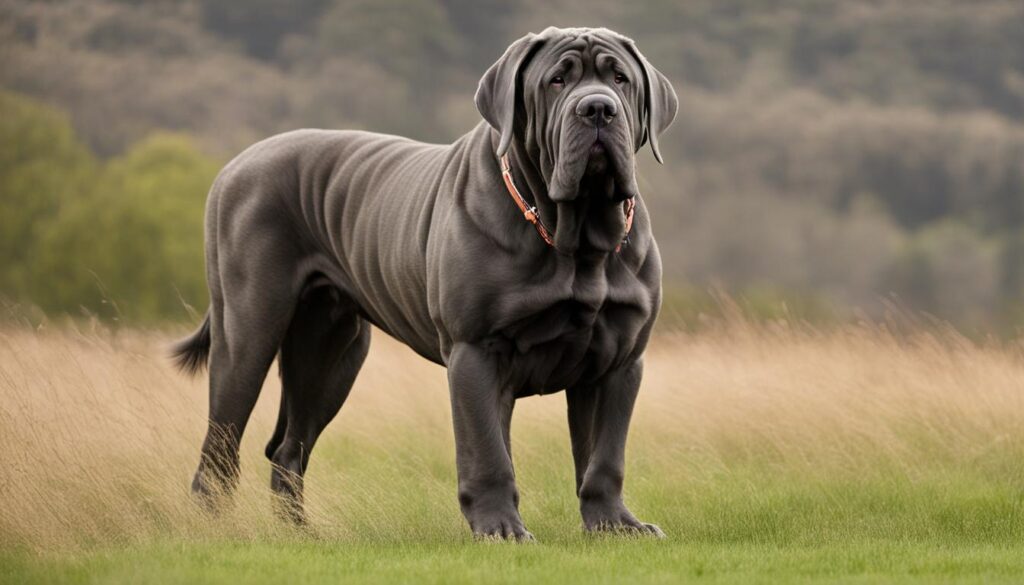
The Neapolitan Mastiff is a massive dog breed known for its protective instincts and gentle nature. Originating from southern Italy, these dogs have a unique appearance with heavily wrinkled skin and a muscular body. Neapolitan Mastiffs were bred for protecting homes, and their loose skin makes it difficult for predators to grab hold of them. Despite their size, they consider themselves lapdogs and have a surprisingly quiet demeanor. Proper training and socialization are important for Neapolitan Mastiffs due to their large size.
This picture showcases the Neapolitan Mastiff’s imposing presence and powerful physique. With its distinctive features and protective nature, this giant dog breed stands out among others.
Key Features of the Neapolitan Mastiff
- Size: Neapolitan Mastiffs are giant dogs, with males typically weighing between 130-155 pounds and standing 26-31 inches tall at the shoulder.
- Protective Instincts: These dogs have a strong sense of loyalty and are naturally protective of their families and territories.
- Gentle Nature: Despite their intimidating appearance, Neapolitan Mastiffs are known for their gentle and affectionate temperament.
- Quiet Demeanor: They have a calm and laid-back nature, making them well-suited for indoor living.
- Wrinkled Skin: Their loose and wrinkled skin not only adds to their unique appearance but also provides an advantage in protecting them from potential injuries.
| Pros | Cons |
|---|---|
| Excellent guard dogs | Requires early and consistent training |
| Great with children when properly socialized | Requires regular exercise and mental stimulation |
| Loyal and affectionate | Prone to health issues such as hip dysplasia and bloat |
| Low exercise needs | Not suitable for apartment living due to their size |
“The Neapolitan Mastiff’s impressive size and protective nature make them excellent guardians. Their wrinkled skin and muscular build give them an imposing presence that is unmatched. While they may look fierce, they are inherently gentle and affectionate, making them loyal family companions.”
Great Dane
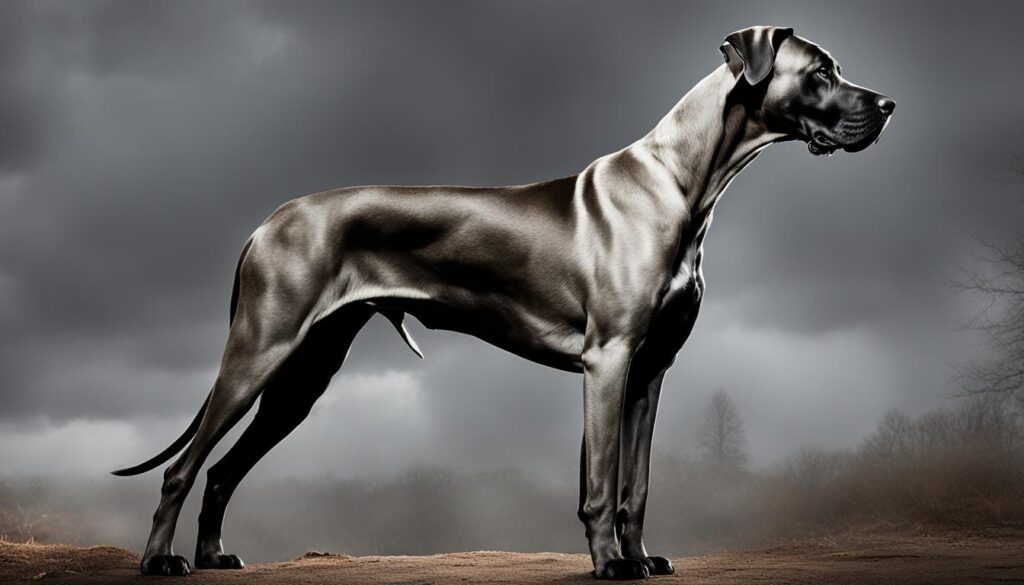
Great Danes are often referred to as gentle giants due to their elegant stature and friendly nature. They are known for their tall height and graceful gait, which makes them one of the tallest dog breeds. Great Danes can reach impressive heights and have a lean and muscular build. Despite their size, they are affectionate and thrive on companionship. However, they require proper training and socialization to prevent any potential behavioral issues.
Great Danes have a majestic stature that captures the attention of anyone around them. Standing at an average height of 30-32 inches at the shoulder, these dogs command respect with their regal presence. Their weight can range from 100 to 200 pounds, making them a true embodiment of the term “gentle giant.”
With their friendly and gentle nature, Great Danes are excellent family pets. They are known for their affectionate and patient demeanor, making them great companions for both adults and children. Despite their large size, Great Danes are often described as loving and patient with younger family members. They are even known to be particularly gentle with small children, earning them the well-deserved reputation of being a family-oriented breed.
Proper training and socialization are essential for Great Danes due to their size and strength. They are intelligent dogs, but they can also be stubborn at times. Consistent and positive reinforcement training methods work best with these gentle giants, helping them develop into well-behaved and obedient companions.
Characteristics of Great Danes:
- Height: 30-32 inches at the shoulder
- Weight: 100-200 pounds
- Build: Lean and muscular
- Temperament: Gentle, friendly, and patient
- Trainability: Intelligent but can be stubborn
Overall, Great Danes possess a majestic stature, a friendly nature, and a striking appearance that sets them apart. Their gentle temperament and companionship make them beloved family pets for those who appreciate the grace and presence of these magnificent dogs.
Top 20 Largest Dog Breeds (according to the American Kennel Club)
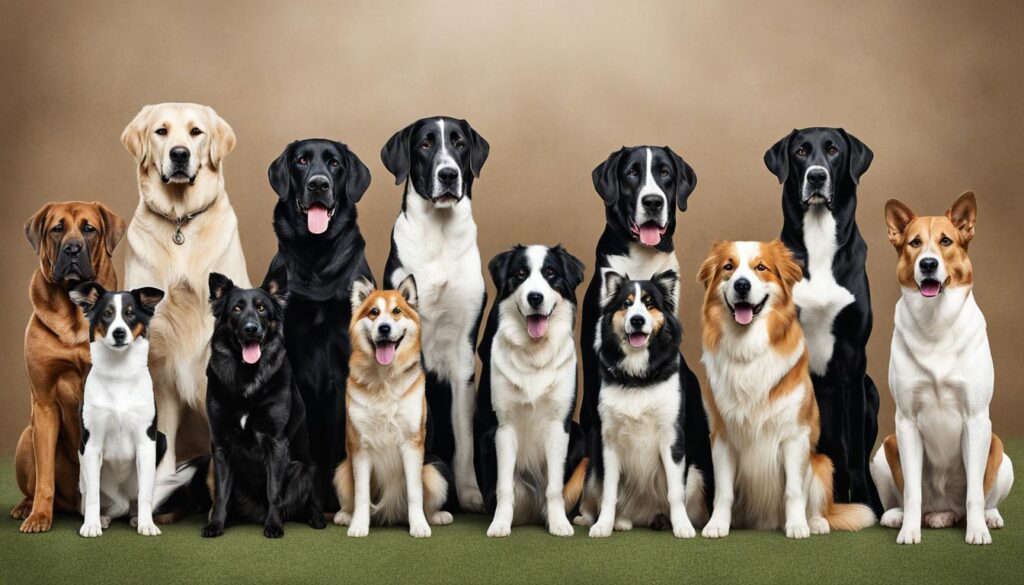
When it comes to large dog breeds, the American Kennel Club recognizes several impressive ones that stand out for their size. These breeds not only have immense physical stature but also possess unique characteristics that make them truly remarkable. Let’s take a closer look at the top 20 largest dog breeds, according to the American Kennel Club.
Below is a table showcasing these magnificent breeds, their average sizes, and some interesting facts:
| Breed | Average Size | Interesting Fact |
|---|---|---|
| Mastiff | Largest dog breed | Known for its gentle and protective nature |
| Boerboel | Large and muscular | Originated in South Africa as a farm guardian |
| Tosa Inu | Impressive size | Originally bred for dog fighting in Japan |
| Saint Bernard | Large and powerful | Famous for its rescue work in the Swiss Alps |
| Great Dane | Tallest dog breed | Known for its friendly and gentle nature |
| Leonberger | Glamorous and majestic | Resembles a lion in appearance |
| Neapolitan Mastiff | Muscular and protective | Originated in southern Italy as a guardian |
| Newfoundland | Water-loving giant | Excellent swimmers and natural rescuers |
| Anatolian Shepherd | Strong and agile | Originally bred to protect livestock in Turkey |
| Tibetan Mastiff | Massive and powerful | Guardian and watchdog from the Tibetan Plateau |
These are just a few of the largest dog breeds recognized by the American Kennel Club. Each breed has its own unique qualities, but they all share impressive sizes that make them stand out in the dog world.
Whether you’re captivated by the protective nature of the Mastiff, the majestic presence of the Great Dane, or the water-loving nature of the Newfoundland, these giant breeds offer a lot to admire and appreciate. Keep in mind that owning a large breed comes with specific considerations, such as providing ample space and meeting their exercise needs.
As a responsible owner, it’s important to provide proper training, socialization, and veterinary care to ensure these magnificent dogs live happy, healthy lives.
Continue reading the article to discover expert opinions on large dog breeds and gain valuable insights into responsible ownership of these gentle giants.
Expert Opinions on Large Dog Breeds
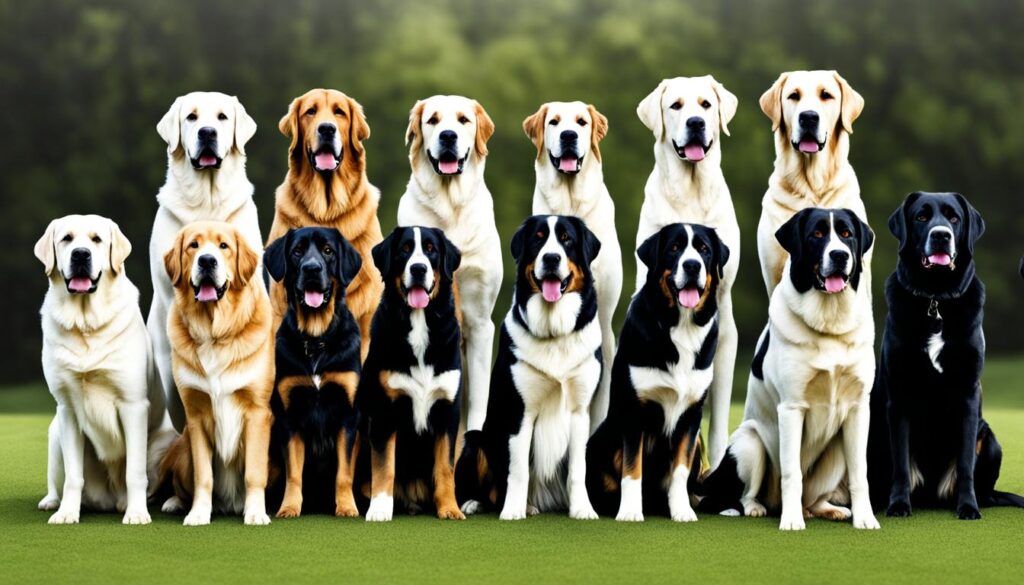
When it comes to owning large dog breeds, experts emphasize the importance of understanding the specific considerations that come with these magnificent dogs. From their slower maturation and development to the need for larger living spaces and higher expenses, owning a large breed requires careful planning and dedication.
“Large dog breeds tend to have a longer growth period compared to smaller breeds,” says Dr. Melissa Johnson, a renowned veterinary expert. “Their bodies and minds take more time to fully develop, so it’s essential to provide them with appropriate nutrition, exercise, and mental stimulation throughout their growing years.”
“Proper behavioral training is crucial, especially for large breeds,” says Karen Thompson, a professional dog trainer with over 20 years of experience. “Their size and strength can pose challenges if they are not well-trained and socialized. Consistent, positive reinforcement training methods work best for these dogs, ensuring they understand their boundaries and behave appropriately in different situations.”
Outdoor space is another key consideration for large breed owners. According to Emily Sanders, an animal behaviorist, “Large dogs need ample space to roam, play, and exercise. A securely fenced yard or access to a dog park is ideal for them to expend their energy and prevent them from feeling confined.”
When it comes to healthcare, choosing a veterinarian experienced in handling giant breeds is crucial. Dr. Michael Harris, a veterinary specialist, advises, “Look for a veterinarian who has knowledge and experience dealing with the distinct health concerns that affect large breeds. From orthopedic issues to breed-specific conditions, a knowledgeable veterinarian will ensure your dog receives the best possible care.”
Overall, owning a large dog breed can be a rewarding experience, but it requires dedication, proper training, and expert guidance. From understanding their unique growth patterns to providing them with the space and care they need, large breeds deserve the special attention they command.
| Considerations when Owning Large Dog Breeds: | Expert Opinion: |
|---|---|
| Slower maturation and development | Dr. Melissa Johnson, Veterinary Expert |
| Proper behavioral training | Karen Thompson, Professional Dog Trainer |
| Space and exercise needs | Emily Sanders, Animal Behaviorist |
| Choosing an experienced veterinarian | Dr. Michael Harris, Veterinary Specialist |
Expert Insights from Spot
As an insurance provider, Spot has conducted internal research on the insurance claim costs associated with giant dog breeds. Our findings reveal that these breeds can incur significantly higher claim costs compared to other breeds. Breeds such as Boerboels, Cane Corsos, Great Danes, Saint Bernards, and Tibetan Mastiffs see average claim costs ranging from 20% to 35% higher.
Several factors contribute to these increased costs. The size of giant dog breeds often necessitates more extensive medical care and specialized equipment, resulting in higher veterinary expenses. Moreover, certain genetic predispositions in these breeds can lead to a higher likelihood of health issues, resulting in more frequent or costly medical treatments.
Additionally, giant breeds require specific care to support their size and physical well-being. This includes specialized diets, larger living spaces, and potentially increased maintenance costs, such as grooming and training. All these factors combined contribute to the higher insurance claim costs associated with giant dog breeds.
Understanding the potential expenses that come with owning a giant breed is crucial for responsible ownership. It’s essential to consider the financial implications and ensure that you can provide the necessary care and coverage for your beloved giant canine companion.
| Giant Dog Breed | Average Claim Costs compared to other Breeds |
|---|---|
| Boerboel | 20% higher |
| Cane Corso | 25% higher |
| Great Dane | 30% higher |
| Saint Bernard | 25% higher |
| Tibetan Mastiff | 35% higher |
Table: Average insurance claim cost increase for select giant dog breeds compared to other breeds.
While these increased costs may seem daunting, it’s important to remember that providing the best care for your giant breed companion is a worthwhile investment. By understanding the potential expenses and ensuring you have appropriate insurance coverage, you can give your giant dog the love and care they deserve.
Conclusion
In conclusion, the world of giant dog breeds is filled with impressive sizes and unique characteristics. From the Irish Wolfhound, Saint Bernard, and Newfoundland to the Great Dane, Leonberger, and Neapolitan Mastiff, these dogs capture our hearts with their gentle nature and loyal companionship.
Owning a giant breed comes with specific considerations, and responsible ownership includes providing them with the care and training they need. These magnificent dogs add a special presence to our lives and continue to be cherished family members.
Whether it’s the majestic stature of the Great Dane, the protective instincts of the Neapolitan Mastiff, or the water-loving nature of the Newfoundland, giant dog breeds bring joy and fulfillment to their owners. From their impressive sizes to their friendly and affectionate personalities, giant dog breeds have a remarkable impact on our lives.
So, if you’re considering adding a furry friend to your family and are up for the challenge of owning a larger-than-life companion, explore the world of giant dog breeds. These loyal and loving giants will undoubtedly leave an indelible mark on your heart.
FAQ
What are the top 10 biggest dog breeds?
The top 10 biggest dog breeds are the Irish Wolfhound, Saint Bernard, Newfoundland, Dogue de Bordeaux, Leonberger, Anatolian Shepherd, Neapolitan Mastiff, Great Dane, Mastiff, Boerboel, Tosa Inu, and Tibetan Mastiff.
What is the Irish Wolfhound breed known for?
The Irish Wolfhound is known for its impressive size and gentle nature, earning it the nickname “gentle giant.
Where did the Saint Bernard breed originate?
The Saint Bernard breed originated from a Swiss monastery at Great St Bernard Pass and initially served as protection dogs.
Why are Newfoundlands called “Newfies”?
Newfoundlands are often called “Newfies” as a shortened form of their breed name and are famous for their love of water and ability to retrieve heavy loads.
What is the distinguishing feature of the Dogue de Bordeaux?
The Dogue de Bordeaux, also known as the French Mastiff, is notable for its wrinkled face and reddish fawn coloration.
Where did the Leonberger breed originate?
The Leonberger breed originated in Leonberg, Germany, and is often referred to as a giant breed that resembles a lion.
What is the Anatolian Shepherd known for?
The Anatolian Shepherd is known for its role in protecting livestock on the Central Anatolian Plateau and its strong protective instincts.
What are the characteristics of the Neapolitan Mastiff?
The Neapolitan Mastiff is a massive dog breed with protective instincts, gentle nature, and unique wrinkled skin.
Why are Great Danes called “gentle giants”?
Great Danes are often called “gentle giants” due to their elegant stature, friendly nature, and graceful gait.
What are the top 20 largest dog breeds according to the American Kennel Club?
The top 20 largest dog breeds according to the American Kennel Club include the Mastiff, Boerboel, Tosa Inu, Saint Bernard, Great Dane, Leonberger, Neapolitan Mastiff, Newfoundland, Anatolian Shepherd, and Tibetan Mastiff, among others.
What considerations should be made when owning large dog breeds?
When owning large dog breeds, it’s important to consider their slower maturation, need for larger living spaces, higher expenses for food and veterinary care, and the importance of proper behavioral training.
Why are insurance claim costs higher for giant dog breeds?
Insurance claim costs for giant dog breeds can be higher due to factors such as size, genetic predispositions, and specific care requirements associated with these breeds.
Reference
- https://www.forbes.com/advisor/pet-insurance/pet-care/largest-dog-breeds/
- https://www.akc.org/dog-breeds
Please also check other articles on this website like:
Siberian Husky 101: A Comprehensive Guide for First-Time Owners
The Ultimate Tibetan Mastiff Dog: History, Characteristics, and Care Tips (2023-24)
Papillon Dog: Everything You Must Know Before You Own One (2023-24)
The Ultimate Tibetan Mastiff Dog: History, Characteristics, and Care Tips (2023-24)
The Catahoula Leopard Dog: A Ultimate Guide 2023 – 24.
Maremma Sheepdog: A Loyal and Fearless Guardian of Livestock 2023
The Mighty Kangal Shepherd Dog: History, Characteristics and Care Guide.
Portuguese Water Dog: The Ultimate Guide to its History, Characteristics, and Care (2023)
10 Dogs Who Are Born to Be Working Dogs
Labrador Retriever vs. Golden Retriever: Which Breed Is Right for You in 2023?
10 Best Dogs Who Are Surprisingly Good Swimmers
The Top 10 Most Popular Dog Breeds in America
A Comprehensive Guide to Havanese Dogs 2023: History, Characteristics, Care, and Training
Toy Dog Breeds: Small Dogs with Big Personalities
Top 25 Medium Size Dog Breeds for First Time Owners
The Essential Guide to Newfoundland Dogs 2023
A Comprehensive Guide to the Most Popular Hunting Dog Breeds
A Comprehensive Guide to the Dogo Argentino – Everything You Need to Know
Top 10 Rare Dog Breeds: The Hidden Gems of the Canine World
15 Most Expensive Dog Breeds: A Comprehensive Guide
Bernese Mountain Dog:10 Surprising Facts That You May Not Have Known.
Bengal Cats – A Complete Guide to Understanding and Caring for These Magnificent Felines
Persian Cat: Your Ultimate Guide to This Regal Breed
Discover the Unique Charm of the Sphynx Cat Breed (2023-24)
The Ultimate Guide to Aardvarks: Everything You Need to Know!

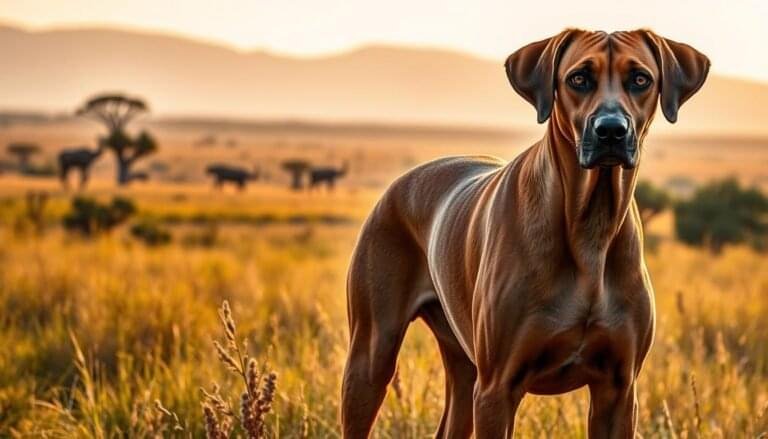
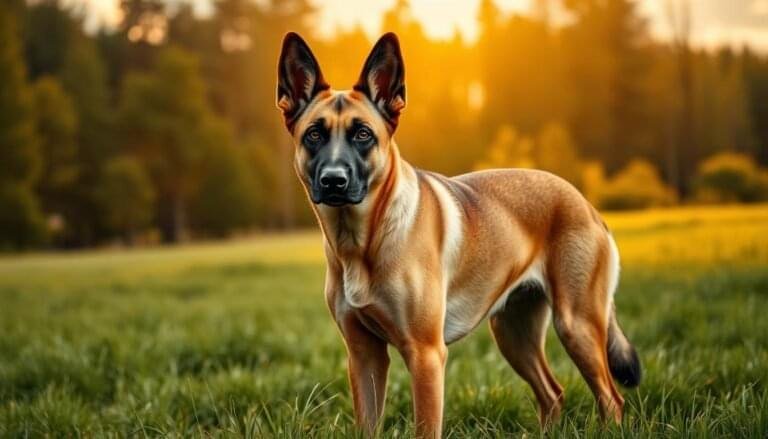
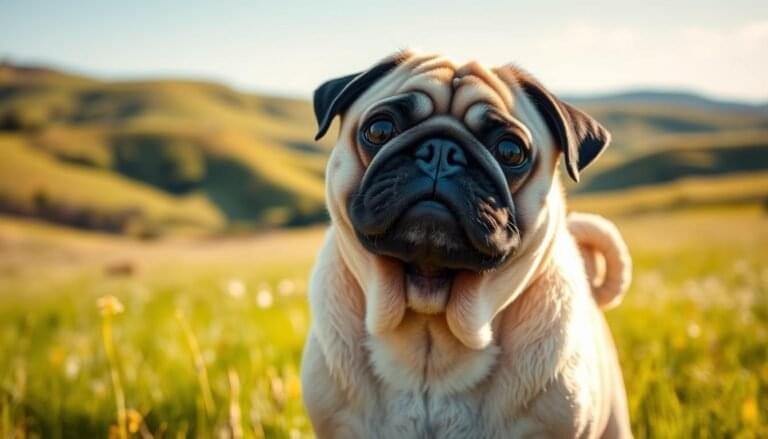

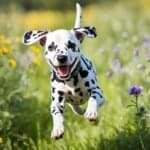


[…] Preservation of an indigenous dog breed […]
[…] that can influence the number of kittens a cat has. The mother’s age, breed, health, and breeding frequency all play a role in determining the size of the […]
[…] can vary based on several factors, including breed, age, and activity level. For example, certain breeds may have specific sleep requirements due to their size or genetic predisposition. Additionally, young and active pets may need more sleep to recharge […]
[…] the Anatolian Shepherd’s physique is a testament to its versatility and endurance. The breed’s size, build, and coat length contribute to its capabilities as a protector, ensuring it is capable of […]
[…] is a captivating and versatile breed that belongs to the Non-Sporting breed group. This beautiful breed comes in three different sizes: toy, miniature, and standard. Each size has its own unique characteristics and weight […]
[…] thinking about how big a mature cat should be, the breed matters a lot. Different breeds have different sizes on average. Genes and health also influence a cat’s size. Talking to a vet or looking at breed […]